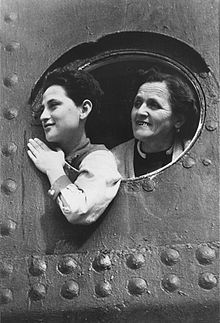
Back Илюминатор Bulgarian Ull de bou (nàutica) Catalan Bullauge German Ŝipluko Esperanto Ojo de buey Spanish Illuminaator Estonian Idi-begi Basque Hublot French Ollo de boi (naútica) Galician אשנב HE
This article needs additional citations for verification. (April 2016) |

A porthole, sometimes called bull's-eye window or bull's-eye,[1] is a generally circular window used on the hull of ships to admit light and air. Though the term is of maritime origin, it is also used to describe round windows on armored vehicles, aircraft, automobiles (the Ford Thunderbird a notable example) and even spacecraft.
On a ship, the function of a porthole, when open, is to permit light and fresh air to enter the dark and often damp below-deck quarters of the vessel. It also affords below-deck occupants a limited view to the outside world.[2] When closed, the porthole provides a strong water-tight, weather-tight and sometimes light-tight barrier.
A porthole on a ship may also be called a sidescuttle or side scuttle (side hole), as officially termed in the International Convention for the Safety of Life at Sea. This term is used in the U.S. Code of Federal Regulations.[3] It is also used in related rules and regulations for the construction of ships.[4] The use of the word "sidescuttle" instead of "porthole" is meant to be broad, including any covered or uncovered hole in the side of the vessel. A deadlight is a hinged metal cover which can be clamped over the porthole to secure it in heavy weather.
- ^ bull's-eye in the American Heritage dictionary
- ^ "10 things I wish I knew before going on my first cruise". The Daily Telegraph. 9 June 2017.
- ^ Title 46 U.S. Code of Federal Regulations Sec. 45.139 - Side scuttles.
- ^ ISO (1993) ISO 1751. Shipbuilding and marine structures - Ships' side scuttles. International Organization for Standardization.